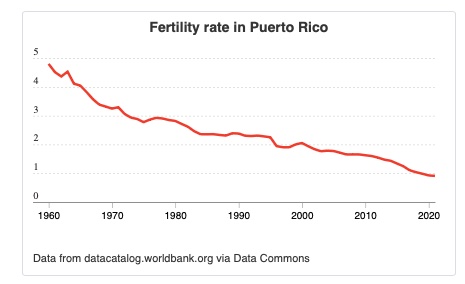A strike was just averted at Puerto Rico’s largest medical care facility, the Medical Center in San Juan. Healthcare workers there were prepared to strike for higher pay, in a territory which offers lower pay to medical professionals than any state.
This was just another data point in a long saga of problems in Puerto Rico’s healthcare system. Hospitalization of people receiving home care have increased from 15.2% to 18.6% since 2015.
Now another healthcare issue has hit the headlines. Caesarean sections, birth by surgery, have skyrocketed in Puerto Rico. more than half of all babies are now delivered by surgery, compared with fewer than one third in the states. In Bayamón, the proportion is 63.9%. These rates are among the highest in the world. The World Health Organization recommends a rate of 10%.
Economics
Puerto Rico receives $4,290 per capita each year, compared with $12,218 per capita for states. Healthcare providers receive significantly less pay, and there is a shortage of doctors. These disadvantages have led to some doctors’ scheduling C-sections automatically to cope with shortages and financial shortfalls. Part of the problem may come from doctors being unwilling to take the time involved in a typical birth, compared with a conveniently-scheduled surgical birth. However, those decisions are also required by the need to make sure there will be enough staff available for the birth, in light of the shortages.
U.S. News also reports that epidurals (pain medication for labor and delivery) are often not covered by insurance in Puerto Rico. This inequity encourages women to choose a C-section for fear of pain associated with childbirth.
C-sections are generally considered to be appropriate only in cases of danger to the mother or baby. The Centers for Disease Control explain that C-sections are major surgery, and come with both higher costs and worse health outcomes. The Puerto Rico Health Department told the U.S. News that 80% of women receiving C-Sections did not have medical issues indicating a need for these surgeries.
Birth rates
Puerto Rico has an extremely low birth rate, the lowest in the United States. Some healthcare professionals say that the high rate of C-sections causes mothers to stop their families at one child, further reducing the birth rate. There is also evidence that C-sections reduce fertility among women, making it more difficult for them to have another child.
The fertility rate in Puerto Rico has fallen to .9 — less than one child for each woman.
The result, in combination with the large numbers of people who feel that they must move to the mainland for the opportunities available to people living in states, is an aging population and a dwindling tax base.








No responses yet